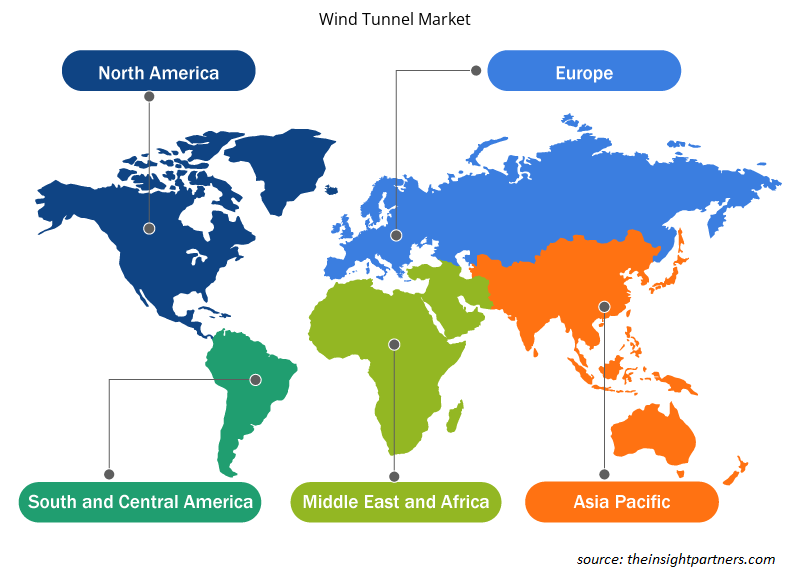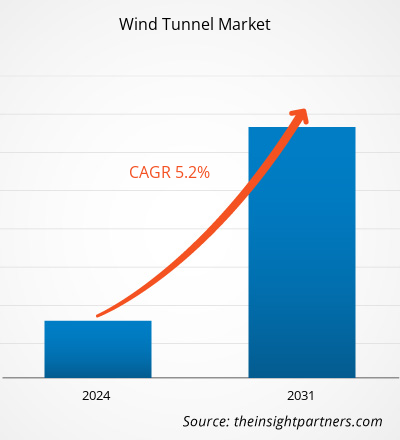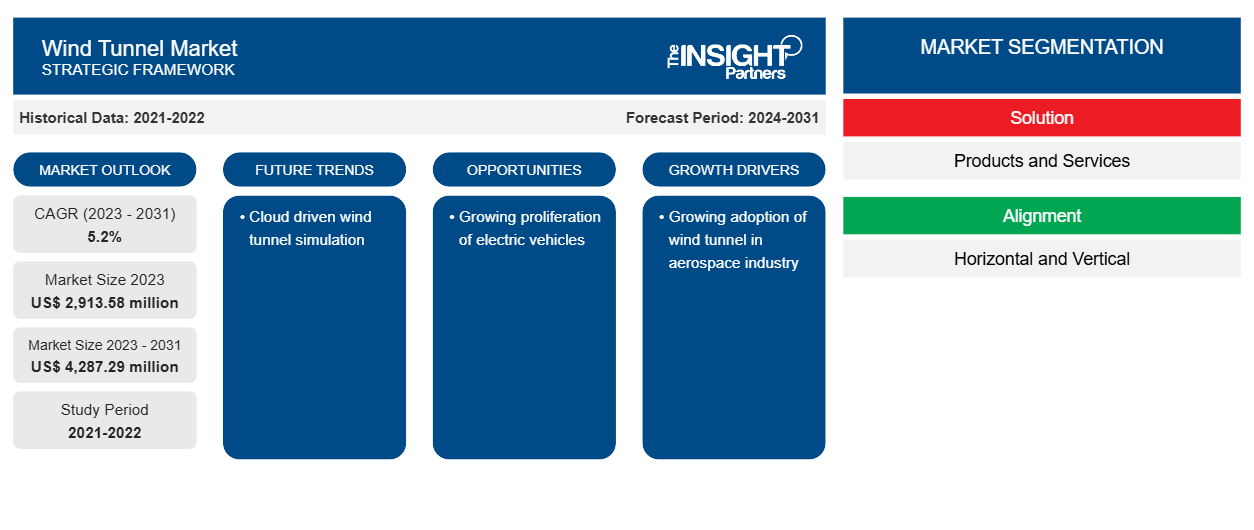Der Markt für Windkanäle soll von 2.913,58 Millionen US-Dollar im Jahr 2023 auf 4.287,29 Millionen US-Dollar im Jahr 2031 anwachsen. Der Markt soll zwischen 2023 und 2031 eine durchschnittliche jährliche Wachstumsrate (CAGR) von 5,2 % verzeichnen. Die wachsende Entwicklung im Bausektor dürfte ein wichtiger Trend auf dem Markt bleiben.
Windkanal-Marktanalyse
Die zunehmenden staatlichen Investitionen in die Fertigungskapazitäten von Entwicklungsländern und die Modernisierung von Wartungsdienstleistungen sowie Fortschritte in der Technologie von Testeinrichtungen werden voraussichtlich die Nachfrage nach Windkanälen in den Endverbrauchsbranchen in den kommenden Jahren ankurbeln. Endverbraucher von Windkanälen sind Großindustrien wie die Automobil- und Luftfahrtindustrie, die die Marktdynamik direkt beeinflussen. Derzeit treiben der Sektor für Elektrofahrzeuge im Automobilbereich und die Sektoren für die Herstellung von UAVs und Verteidigungsflugzeugen/-raketen im Luft- und Raumfahrtbereich das Marktwachstum an.
Windkanal-Marktübersicht
Die wachsende Nachfrage nach grüner Infrastruktur und die zunehmende Verbreitung von Elektrofahrzeugen dürften die Nachfrage nach dem Windkanalmarkt weltweit ankurbeln. Die zunehmende Anwendung von Windkanälen in der Luft- und Raumfahrtbranche treibt das Wachstum des Windkanalmarktes auf globaler Ebene voran. Mit dem Markt sind hohe Kosten und betriebliche Herausforderungen verbunden, die das Wachstum behindern könnten. Die zunehmende Verbreitung von Cloud-basierten Windkanalsimulationen dürfte jedoch das Wachstum des Windkanalmarktes weltweit vorantreiben.
Passen Sie diesen Bericht Ihren Anforderungen an
Sie erhalten kostenlos individuelle Anpassungen an jedem Bericht, einschließlich Teilen dieses Berichts oder einer Analyse auf Länderebene, eines Excel-Datenpakets sowie tolle Angebote und Rabatte für Start-ups und Universitäten.
-
Holen Sie sich die wichtigsten Markttrends aus diesem Bericht.Dieses KOSTENLOSE Beispiel umfasst eine Datenanalyse von Markttrends bis hin zu Schätzungen und Prognosen.
Treiber und Chancen auf dem Windkanalmarkt
Wachsende Verbreitung von umweltfreundlichem Bauen begünstigt den Markt
Die zunehmende Betonung umweltfreundlicher und nachhaltiger Ansätze im Bausektor wird voraussichtlich das Wachstum des Windkanalmarktes weltweit ankurbeln. Der Windkanal kann die Windgeschwindigkeit rund um die Gebäudeoberfläche ermitteln. Die Auswirkungen der Windkraft auf das Gebäude sind entscheidend, insbesondere bei Hochhäusern mit großen, dem Wind ausgesetzten Flächen, bei denen die innere Struktur des Gebäudes den resultierenden Kräften standhält. Obwohl die numerische Strömungsmechanik aufgrund schnellerer Computertechnik zunehmend für Strukturtests eingesetzt wird, gilt sie nicht als für den Routineeinsatz in der Strukturplanung von Gebäuden geeignet, da ihre Vorhersagen durch Experimente überprüft werden müssen. Die Bewertung der Auswirkungen der Windkraft auf Hochhäuser , Fabriken und Brücken kann Bauplanern dabei helfen, eine Struktur zu konstruieren, die den Auswirkungen des Windes effizient standhält. Daher fördert die wachsende Verbreitung des Marktes für umweltfreundliches Bauen das Wachstum des Windkanalmarktes.
Steigende Nachfrage nach Elektrofahrzeugen
Die Aerodynamik spielt bei Elektroautos im Gegensatz zu Fahrzeugen mit Verbrennungsmotor eine wichtige Rolle, da die höchste Energieausbeute zum Beschleunigen oder Bergauffahren durch Energierückgewinnung erzielt werden kann. Um den Bedarf an Energierückgewinnung zu decken, führen Automobilingenieure eine aerodynamische Analyse eines elektrischen Personenkraftwagens mithilfe von Windkanälen durch. In Windkanälen werden die primären aerodynamischen Tests eines Elektrofahrzeugs durchgeführt. Die zunehmende Betonung der Umweltverschmutzungsminderung und der steigende Trend zur Einführung von Elektrofahrzeugen dürften dem Windkanalmarkt positive Chancen bieten.
Segmentierungsanalyse des Windkanal-Marktberichts
Wichtige Segmente, die zur Ableitung der Windkanal-Marktanalyse beigetragen haben, sind Lösung, Ausrichtung,Luftgeschwindigkeitstyp und Anwendung.
- Basierend auf der Lösung ist der Windkanalmarkt in Produkte und Dienstleistungen unterteilt. Das Dienstleistungssegment hatte im Jahr 2023 einen größeren Marktanteil.
- Durch die Ausrichtung wird der Markt in horizontal und vertikal segmentiert. Das horizontale Segment hatte im Jahr 2023 einen größeren Marktanteil.
- In Bezug auf die Luftgeschwindigkeitsart ist der Markt in Unterschall, Überschall, Transschall und Hyperschall unterteilt. Das Unterschallsegment hielt im Jahr 2023 einen erheblichen Marktanteil.
- In Bezug auf die Anwendung ist der Markt in Luft- und Raumfahrt und Verteidigung, Automobil und Transport, Hochbau und Windenergie, Training und Simulation, Abenteuersportarten wie Fallschirmspringen und andere unterteilt. Das Segment Luft- und Raumfahrt und Verteidigung hielt im Jahr 2023 einen erheblichen Marktanteil.
Windkanal-Marktanteilsanalyse nach Geografie
Der geografische Umfang des Windkanal-Marktberichts ist hauptsächlich in fünf Regionen unterteilt: Nordamerika, Asien-Pazifik, Europa, Naher Osten und Afrika sowie Süd- und Mittelamerika.
Europa ist Marktführer. Die zunehmende Anwendung von Windkanälen in der Luft- und Raumfahrt sowie im Verteidigungssektor fördert das Wachstum des Windkanalmarktes in Europa. Es gibt verschiedene Arten von Windkanälen, jeder mit seinen eigenen Merkmalen und Geschwindigkeitsbereichen. Forschungszentren und Labore für Flugzeugbau und -design nutzen Windkanäle in hohem Maße. Darüber hinaus wirkt sich auch die zunehmende Anwendung von Unterschall-Windkanälen in der Luft- und Raumfahrt positiv auf das Wachstum des Windkanalmarktes in der Region aus. Die hohe Präsenz von Windkanalprodukten und -dienstleistern in der Region wirkt sich ebenfalls als wichtiger Treiber für den Windkanalmarkt in Europa aus.
Regionale Einblicke in den Windkanalmarkt
Die regionalen Trends und Faktoren, die den Windkanalmarkt während des Prognosezeitraums beeinflussen, wurden von den Analysten von Insight Partners ausführlich erläutert. In diesem Abschnitt werden auch die Marktsegmente und die Geografie des Windkanalmarkts in Nordamerika, Europa, im asiatisch-pazifischen Raum, im Nahen Osten und Afrika sowie in Süd- und Mittelamerika erörtert.

- Holen Sie sich regionale Daten zum Windkanalmarkt
Umfang des Windkanal-Marktberichts
| Berichtsattribut | Details |
|---|---|
| Marktgröße im Jahr 2023 | 2.913,58 Millionen US-Dollar |
| Marktgröße bis 2031 | 4.287,29 Millionen US-Dollar |
| Globale CAGR (2023 - 2031) | 5,2 % |
| Historische Daten | 2021-2022 |
| Prognosezeitraum | 2024–2031 |
| Abgedeckte Segmente |
Nach Lösung
|
| Abgedeckte Regionen und Länder |
Nordamerika
|
| Marktführer und wichtige Unternehmensprofile |
|
Marktteilnehmerdichte: Der Einfluss auf die Geschäftsdynamik
Der Markt für Windkanäle wächst rasant, angetrieben durch die steigende Nachfrage der Endnutzer aufgrund von Faktoren wie sich entwickelnden Verbraucherpräferenzen, technologischen Fortschritten und einem größeren Bewusstsein für die Vorteile des Produkts. Mit steigender Nachfrage erweitern Unternehmen ihr Angebot, entwickeln Innovationen, um die Bedürfnisse der Verbraucher zu erfüllen, und nutzen neue Trends, was das Marktwachstum weiter ankurbelt.
Die Marktteilnehmerdichte bezieht sich auf die Verteilung der Firmen oder Unternehmen, die in einem bestimmten Markt oder einer bestimmten Branche tätig sind. Sie gibt an, wie viele Wettbewerber (Marktteilnehmer) in einem bestimmten Marktraum im Verhältnis zu seiner Größe oder seinem gesamten Marktwert präsent sind.
Die wichtigsten auf dem Windkanalmarkt tätigen Unternehmen sind:
- Aerolab
- Aiolos
- Die Boeing Company
- ETW GmbH
- Horiba GmbH
- Lockheed Martin Corporation
Haftungsausschluss : Die oben aufgeführten Unternehmen sind nicht in einer bestimmten Reihenfolge aufgeführt.

- Überblick über die wichtigsten Akteure auf dem Windkanalmarkt
Neuigkeiten und aktuelle Entwicklungen zum Windkanalmarkt
Der Windkanalmarkt wird durch die Erhebung qualitativer und quantitativer Daten nach Primär- und Sekundärforschung bewertet, die wichtige Unternehmensveröffentlichungen, Verbandsdaten und Datenbanken umfasst. Nachfolgend sind einige der Entwicklungen auf dem Windkanalmarkt aufgeführt:
- MAHLE Klima-Windkanal „wird elektrisch“. MAHLE erweitert das Leistungsspektrum der hochmodernen Anlage in Stuttgart und ermöglicht es, die Auswirkungen des Schnellladens auf empfindliche Li-Ionen-Batterien unter unterschiedlichsten klimatischen Bedingungen zu testen. (Quelle: MAHLE Konzern, Pressemitteilung, Februar 2023)
- Die University of Notre Dame und die Lockheed Martin Corporation haben am 4. November 2021 ein Master Research Agreement unterzeichnet, um zukünftige Kooperationen zur Förderung der Luft- und Raumfahrtforschung zu erleichtern. Dieses Abkommen zeigt den gegenseitigen Wunsch beider Institutionen, ihre laufende produktive Beziehung zu beschleunigen. (Quelle: Lockheed Martin Corporation, Pressemitteilung, November 2021)
Abdeckung und Ergebnisse des Windkanal-Marktberichts
Der Bericht „Marktgröße und Prognose für Windkanäle (2021–2031)“ bietet eine detaillierte Analyse des Marktes, die die folgenden Bereiche abdeckt:
- Windkanalmarktgröße und -prognose auf globaler, regionaler und Länderebene für alle wichtigen Marktsegmente, die im Rahmen des Berichts abgedeckt sind
- Windkanal-Markttrends sowie Marktdynamik wie Treiber, Einschränkungen und wichtige Chancen
- Detaillierte PEST- und SWOT-Analyse
- Windkanal-Marktanalyse mit wichtigen Markttrends, globalen und regionalen Rahmenbedingungen, wichtigen Akteuren, Vorschriften und aktuellen Marktentwicklungen
- Branchenlandschaft und Wettbewerbsanalyse, einschließlich Marktkonzentration, Heatmap-Analyse, prominenten Akteuren und aktuellen Entwicklungen für den Windkanalmarkt
- Detaillierte Firmenprofile
- Historische Analyse (2 Jahre), Basisjahr, Prognose (7 Jahre) mit CAGR
- PEST- und SWOT-Analyse
- Marktgröße Wert/Volumen – Global, Regional, Land
- Branchen- und Wettbewerbslandschaft
- Excel-Datensatz
Aktuelle Berichte
Verwandte Berichte
Erfahrungsberichte
Grund zum Kauf
- Fundierte Entscheidungsfindung
- Marktdynamik verstehen
- Wettbewerbsanalyse
- Kundeneinblicke
- Marktprognosen
- Risikominimierung
- Strategische Planung
- Investitionsbegründung
- Identifizierung neuer Märkte
- Verbesserung von Marketingstrategien
- Steigerung der Betriebseffizienz
- Anpassung an regulatorische Trends























 Kostenlose Probe anfordern für - Windkanalmarkt
Kostenlose Probe anfordern für - Windkanalmarkt